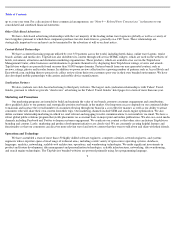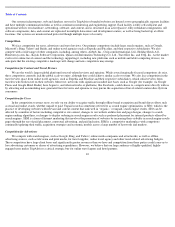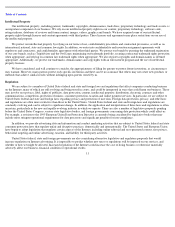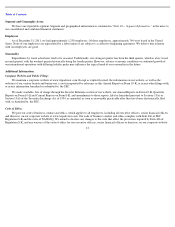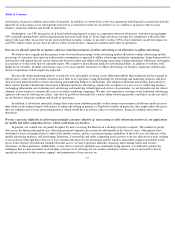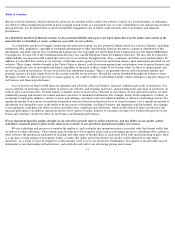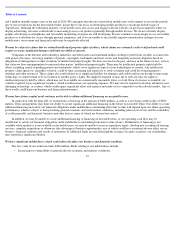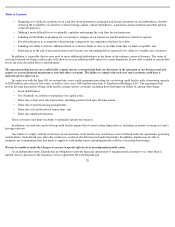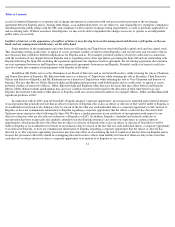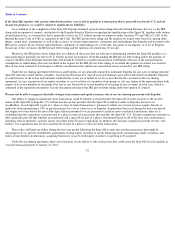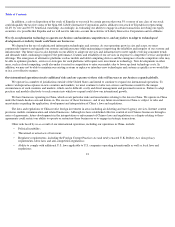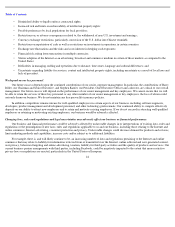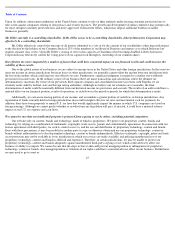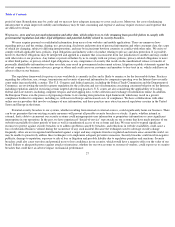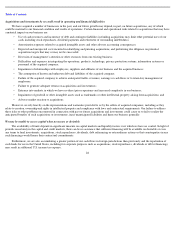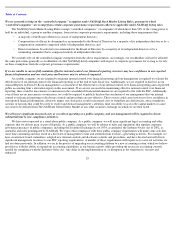TripAdvisor 2011 Annual Report Download - page 23
Download and view the complete annual report
Please find page 23 of the 2011 TripAdvisor annual report below. You can navigate through the pages in the report by either clicking on the pages listed below, or by using the keyword search tool below to find specific information within the annual report.
Table of Contents
and 4 million monthly unique users at the end of 2010. We anticipate that the rate of growth in mobile users will continue to exceed the growth
rate of our overall users for the foreseeable future, in part due to our focus on developing mobile products to encourage mobile usage of
TripAdvisor. Although the substantial majority of our mobile users also access and engage with our websites on personal computers where we
display advertising, our users could decide to increasingly access our products primarily through mobile devices. We do not currently display
graphic advertising on smartphones and our mobile monetizing strategies are still developing. If users continue to increasingly access our mobile
products as a substitute for access through personal computers, and if we are unable to successfully improve monetization strategies for our
mobile users, our revenue and financial results may be negatively affected.
We may be subject to claims that we violated intellectual property rights of others, which claims are extremely costly to defend and could
require us to pay significant damages and limit our ability to operate.
Companies in the Internet and technology industries, and other patent and trademark holders seeking to profit from royalties in connection
with grants of licenses, own large numbers of patents, copyrights, trademarks and trade secrets and frequently enter into litigation based on
allegations of infringement or other violations of intellectual property rights. We have received in the past, and may in the future receive, notices
that claim we have misappropriated or misused other parties’ intellectual property rights. There may be intellectual property rights held by
others, including issued or pending patents and trademarks, which cover significant aspects of our technologies or content. Any intellectual
property claim against us, regardless of merit, could be time consuming and expensive to settle or litigate and could divert management’s
attention and other resources. These claims also could subject us to significant liability for damages and could result in our having to stop using
technology or content found to be in violation of another party’s rights. We might be required or may opt to seek a license for rights to
intellectual property held by others, which may not be available on commercially reasonable terms, or at all. Even if a license is available, we
could be required to pay significant royalties, which would increase our operating expenses. We may also be required to develop alternative non-
infringing technology, or content, which could require significant effort and expense and make us less competitive in the relevant market. Any of
these results could harm our business and financial performance.
We may have future capital needs and may not be able to obtain additional financing on acceptable terms.
In connection with the Spin-Off, we entered into a term loan in the amount of $400 million, as well as a revolving credit facility of $200
million. These arrangements may limit our ability to secure significant additional financing in the future on favorable terms. Our ability to secure
additional financing and satisfy our financial obligations under indebtedness outstanding from time to time will depend upon our future operating
performance, which is subject to then prevailing general economic and credit market conditions, including interest rate levels and the availability
of credit generally, and financial, business and other factors, many of which are beyond our control.
In addition, we may be unable to secure additional financing or financing on favorable terms, or our operating cash flow may be
insufficient to satisfy our financial obligations under indebtedness outstanding from time to time (if any). Furthermore, if financing is not
available when needed or is not available on favorable terms, we may be unable to issue or repurchase equity, develop new or enhanced existing
services, complete acquisitions or otherwise take advantage of business opportunities, any of which could have a material adverse effect on our
business, financial condition and results of operations. If additional funds are raised through the issuance of equity securities, our stockholders
may experience significant dilution.
We have significant indebtedness, which could adversely affect our business and financial condition.
The face value of our term loan totals $400 million. Risks relating to our indebtedness include:
19
•
Increasing our vulnerability to general adverse economic and industry conditions;


